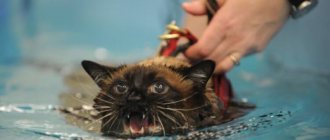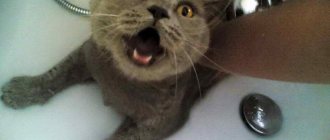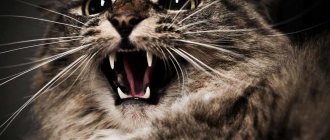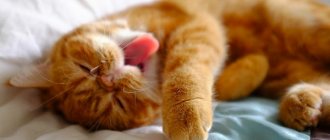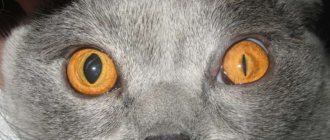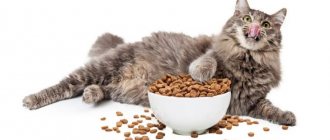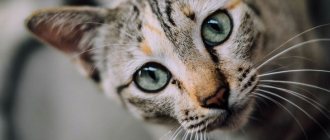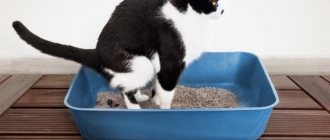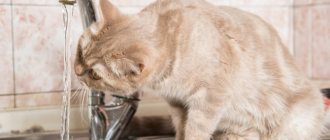Do you know if there is cat breeds that love water? Surprisingly true! And not only do they enjoy it, many of these cat breeds love to bathe and swim! In some cases, this passion for water is innate. But with other cat breeds, they need to be socialized and introduced to water properly. Many cats have a bad relationship with water because they perceive it as a negative stimulus when they really shouldn't.
If you want to learn more about cats and water and better understand this relationship, I've come to the right place. Here on HowMeow.ru we will discuss cat breeds that love water . Additionally, we will analyze why cats hate water (in general).
Why do cats hate water??
Why are cats afraid of water? ? Well, this is one of the most frequently asked questions among cat lovers who are having a really tough time when it comes to bathing their cats. Additionally, many cats also refuse to drink water from their bowls, which adds to the confusion for any pet owner. Well, go analyze. This is why cats are attracted to moving water, unless your cat drinks standing water; replace it with another source of water. Did you know that a cat weighing about 5 kg should drink an average of 250 ml of water per day? Depending on the cat's specific diet, this figure may increase or decrease. Want to know more about because your cat isn't drinking water ? Click here for more!
Now why don't cats like water? Well, there are several theories that discuss the cause of this fear, although there is still no clear and definitive answer. One of the most common theories goes back to the origins of cat breeds. Most of the original cat breeds come from desert areas in the Middle East where water is limited. Another theory states that the idea of being submerged in water makes the cat's robe heavy. This heavy, wet fur makes the cat feel uncomfortable, less agile and somewhat immobile. This adds to the cat's feeling of being trapped, compromising the cat's freedom of movement and rapid response to threats and/or dangers.
Despite this, cat evolution has forced cats to come into contact with water throughout history. In fact, cats need water to survive, hunt and fish. Because of this, many cat breeds have adapted to water. But remember that cat formation and learning play a fundamental role in the cat's relationship with water. This is especially important when it comes to bathing your cat. So, regardless of the breed, if your cat gets into the water incorrectly, you won't like it.
Do cats love baths???
In general, no, cats don't like bathrooms. The reason for this is related to what we mentioned earlier; heavier mantle. Bathing cats is often a source of fear and stress, mainly because cats feel confined and immobile. However, this negative association between cats and water can be avoided through proper socialization. Many cat guardians make the mistake of forcing their cats to bathe, don't do this .
Forcing your cat to bathe will increase the stress on your cat, and your cat will in turn hate baths more. In fact, forcing your cat to bathe is counterproductive to its cognitive development in cats. So if you're teaching your cat to bathe, be patient. For best results, imagine your cat in the water when she is a kitten.
How to bathe a cat correctly?
There are several quite valuable tips that can help you if you decide to give your pet a bath.
- First of all, you must understand that your pet does an excellent job of cleaning its fur. Therefore, you only need to wash it if it is really very dirty or if it has parasites.
- If you don’t want to make your cat feel uncomfortable, you can use a special dry shampoo that does not require the use of water. True, it is advisable to use this method no more than once every six months. This method has one noticeable disadvantage - the powder is difficult to clean from carpet surfaces.
- If you decide to wash in the bath, be sure to use nail caps, since we can say with 99% certainty that the cat will scratch you. It is better to carry out the procedure in the bath, as an adult cat can splash all the water in the basin. But kittens can safely be bathed in a basin.
- It is advisable to lay a towel or at least a large piece of fabric at the bottom of the bath. This is necessary so that the pet does not slip, but stays firmly on its paws.
- Now regarding the water. It is recommended to pour slightly warm water up to the cat’s stomach in advance. Why in advance? Because the pet may be frightened by the noise of flowing water and will try to escape.
- After placing your pet in the bath, hold him firmly with both hands. As soon as your grip loosens, the animal will try to escape. It is also desirable that the procedure be carried out by two people - one will hold the cat, and the second will wash it at this time. The main thing is not to be too zealous when rubbing the fur, as this is completely useless.
- The total time that needs to be spent on all water procedures is no more than 10 minutes. Be sure to make sure that water, and especially shampoo, does not get on your pet’s face. Rinse off the foam as thoroughly as possible.
- Finally, wrap your cat in a towel and warm him up for at least a few minutes. It is highly advisable to do this, since in this way you will warm the cat, because after bathing they get very cold. In addition, this will help your pet not to get sick, for example, pneumonia. In any case, after five minutes of being in your arms, he will still try to escape and there is no point in resisting this.
- By the way, as for shampoo, it is advisable to use a product from a well-known manufacturer, since shampoo of an unknown brand can cause, say, an allergy in a cat.
READ How to breed fish in a pond: features of breeding various types of fish in artificial reservoirs
Domestic cat breeds that love water: Norwegian Forest Cat
One of the things that most characterizes the Norwegian Forest Cat is its eagerness when it comes to water. In fact, the Norwegian forest can be an excellent swimmer, despite its abundant mantle. Did you know that Norwegian Forest cats are also one of the oldest cat breeds in the world? These cats were included in many myths and legends of Norse mythology.
The Norwegian Forest Cat, in addition to being on our list of cat breeds that love water, is also known as one of the largest cat breeds in the world. This is a very large cat that can weigh up to 10 kg. His beautiful mantle requires special care to keep him in perfect condition. Taking care of the Norwegian Forest cat's coat requires daily brushing and a proper diet rich in omega 3 and 6. This cat breed also has an affectionate and protective nature...
Why most cats don't like water
If you look at immersion in water itself, as well as its consequences from the cat’s point of view, knowing some of the features of its physiology, then such behavior looks quite reasonable.
Violation of thermoregulation
Most cats, in addition to the guard hair of the coat, also have an undercoat. The undercoat is a large number of shorter and thinner hairs, often located, the main function of which is to retain air. Therefore, the cat is constantly surrounded by a layer of air at a temperature that is comfortable for it.
Cats' dislike of water is explained by the structure of their fur.
When the undercoat gets wet, the cat loses this air layer (and along with it the feeling of comfort) and does not see the opportunity to somehow improve its condition, since such a structure of the coat is its main means of thermoregulation. Only large wild cats can shake themselves off, removing excess water from their fur, as dogs do. Therefore, most cats try to prevent their fur from getting wet.
The instinct of self-preservation
The ancient instincts of a cat do not tell her to enter the water without special reasons for this.
The aquatic environment is not natural for cats
Staying in an aquatic environment requires additional effort for a cat - you need to constantly paddle with your paws so as not to drown; breathing is difficult; there is no support. The cat is the perfect hunter: quiet, swift and accurate; but being in an aquatic environment, she cannot use all these qualities and understands that she herself can become easy prey for a larger animal.
The smell of wet wool intensifies
After getting wet, the cat’s sebaceous glands intensify their work in order to quickly restore part of the secretion lost during bathing, covering the fur and skin with a thin layer and having a protective function. Some of the large sebaceous glands located in the chin and back of the body contain odorous substances, individual for each cat, which are used by it to mark the boundaries of its territory. Activation of the secretion of odorous secretion occurs simultaneously with increased activity of all sebaceous glands, since the glands form a single system. A strong smell unmasks a cat when hunting, and can also attract predators to it, so this is another good reason not to go into the water unless absolutely necessary.
Possibility of infection with infections and helminths
Wet fur retains a large amount of contaminants containing disease-causing pathogens - bacteria, protozoa, viruses and helminth eggs, which will inevitably fall into the cat's mouth when caring for contaminated fur.
Wet wool can harbor pathogenic bacteria.
This is a truly risky situation, the outcome of which depends on the state of the cat's immune system, and the cat instinctively seeks to avoid it.
Stressful state
Each pet is an individual with its own opinion and personal boundaries. This is especially true for cats, which are highly valued for the combination of independence and sincerity in their character. It is almost impossible to force a cat to do anything under duress. And when a cat, against his will, is roughly dipped into a container of liquid, he experiences real stress, since everything that happens is perceived by him as inappropriate behavior on the part of a person. The cat is used to taking care of his fur on his own and is confident that he does a good job of it; he does not see any hygienic advisability in water procedures.
Don't be rough with your cat when bathing.
But, unfortunately, people rarely take into account that their pets have their own individuality, and the use of violence against them is not considered barbaric, although this does not change the essence of the phenomenon.
Unpleasant shampoo odors
An additional factor that turns a cat away from water procedures will be the use of detergents with a smell that is pleasant to the human sense of smell. The sensitivity of a cat’s sense of smell is many times greater than that of a human, and humans and cats also have distinct differences in the subjective perception of “pleasantness-unpleasantness” of odors.
Cats need to be washed with shampoos made specifically for them.
For example, all cats do not like the smell of citrus fruits, and the light and pleasant smell of shampoo with citrus flavoring is perceived by the cat as an indescribable stench of high intensity, which also firmly eats into the fur.
In addition, detergents for humans are too aggressive for animal skin and dry it out.
Big cats that love water: Maine Coon
Maine Coon cats I love water and snow, so bathing a Maine Coon cat is an incredibly fun and enjoyable experience. In addition, Maine raccoons are also sweet, affectionate, attentive, friendly and love to play with water...
Like the Norwegian Forest Cat, Maine raccoons are considered one of the largest cat breeds in the world , weighing between 6 and 10 kg. Additionally, a Maine Coon cat's coat is long, fluffy, and needs to be brushed regularly. For more information about this wonderful cat breed, check out our article: Caring for a Maine Coon Cat.
Cats that swim: Turkish cats
In addition to being beautiful, the Turkish Van is also known as a cat breed that loves water. This cat breed loves to bathe, play with water, and swim in pools, rivers, or lakes. So if you are planning a holiday with your cat in a warm place with water, take your Turkish van with you! But if I don't know how to travel with a cat, no, don't worry! You can take a look at our article at; traveling by car with a cat.
Additionally, this cat breed tends to get along very well with children (they love to play) and also climbs to high places. It is imperative to provide your Turkish truck with adequate environmental enrichment.
Bathing ritual
The ritual should be as follows. Place the cat in a bath with warm water, then carefully and slowly water your pet with a ladle. Be sure to gently pronounce your actions and call the cat’s name. Next, you should pour shampoo onto your hand and warm it so as not to create discomfort for the animal. Gently rub over the fur and make sure that soap suds do not get into your eyes.
When the shampoo is completely rinsed off, you need to wrap the animal in a pre-heated towel or soft cloth and take it to a warm room, where you gently dry it with a towel. At the end of the procedure, you should give your pet some treat.
Cats that love water: Turkish Angora
The Turkish Angora is another favorite cat breed that loves water . This cat breed loves to play with raindrops, fountain water and really enjoys a good bath! As with the cat breeds mentioned above, this cat's fascination with water may seem strange, mainly due to its abundant mantle. But thanks to its evolutionary process and history, this cat breed has adapted to water as a source of positive enrichment...
Again, it is important to emphasize the importance of brushing your Turkish Angora's coat regularly. Additionally, to avoid hairballs, it is important to provide this breed of cat with malt ball paste . Did you know that this cat is one of the oldest cat breeds in the world???
Let's consider scientific assumptions
Possibility of hypothermia
Due to the structural features of the cat's coat, an air layer is maintained between the body and the outer hairs of the cat's fur, which helps balance thermoregulation. This allows you to easily adapt to environmental conditions, avoiding sudden overheating or hypothermia. When the wool gets wet, this feature stops working. The animal begins to freeze, naturally experiencing severe discomfort.
Possibility of overheating
If a cat gets wet in hot weather, this is also not good. Direct sunlight, affecting the body without the protection of an air cushion, can lead the animal to sunstroke or to simple overheating (hyperthermia).
The secretory function of the skin glands is activated
When the wool gets wet, the protective covering of the skin is washed off with a special secretion. As a result, to restore the previous state, the skin glands are activated and secrete more secretions. Since the secretion has a strong odor, the cat becomes “noticeable” both to prey, which prevents successful hunting and food, and to large predators, which threatens its life.
Light soiling from wet wool
This may promote the proliferation of pathogenic microorganisms or fungi. If the weather is damp and cool, the thick coat may remain damp for several days, which can naturally encourage infection.
Interesting! Many cats in the wild are not at all afraid of water and enjoy swimming in cool water (tigers, servals, jaguars). There are wild cats that even successfully hunt in water and are excellent fishers.
Cat breeds that swim: Siberian cats
Siberian cats love to swim and are actually very good at it. This ancient cat breed is the ideal companion for people who love adventure, mountain walking and swimming in lakes. Siberian cats are also a hypoallergenic cat breed, so if you suffer from allergies, this is the perfect cat for you! For more information, check out our list of 10 hypoallergenic cat breeds.
Cat Breed that Loves Water: Does your cat love water??
While your cat may not be on our list of cat breeds that love water , they may still love a good bath! If you notice that your cat loves water, you shouldn't be surprised or worried. Many cats have learned to adapt to water, although this is not an inherent characteristic of their breed. What's also important to know is that mixed breed cats may also love water, especially if they have received adequate education about cats.
Whether your cat likes or doesn't like water, never mind, we'd love for you to share your cat-water experience in our comments section below!
Abyssinian cat
Abyssinian cat Photo: Depositphotos
Representatives of this breed have wild colors and a long history. Ethiopia is considered the birthplace of the animal.
Each Abyssinian representative has his own individual character. Abyssinians are very playful. They can reproduce a huge number of different sounds. The animal loves human communication, but does not like hands.
Abyssinians also have an individual attitude towards the water element. Not all representatives of the breed are happy to “take a bath.” However, games with a stream of water are liked by the vast majority.
